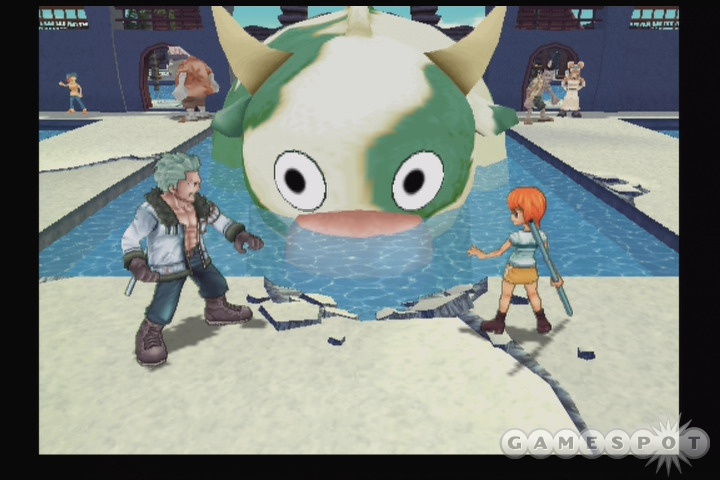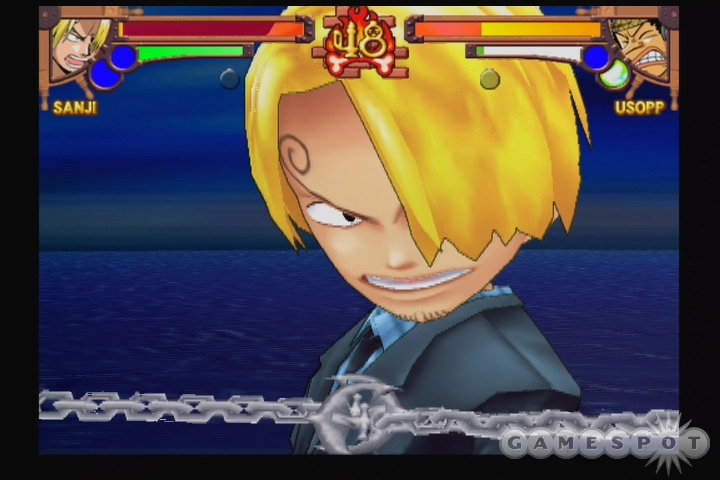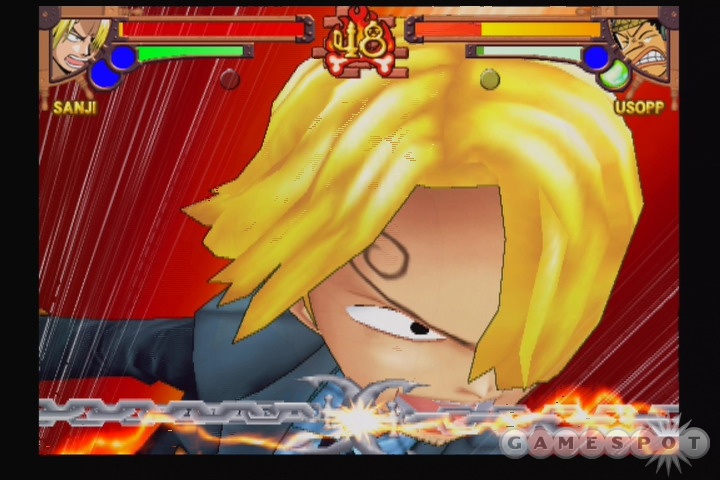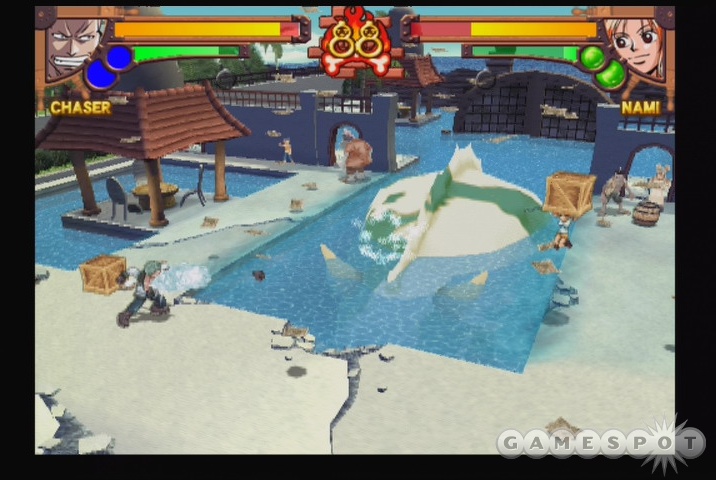Shonen Jump's One Piece: Grand Battle lets you play as the Straw Hat Pirates or their enemies in an arena fighter that's very much inspired by the Power Stone games. Were One Piece also a four-player party game, it might be entertaining. One-on-one confrontations don't pass muster, as they basically become a race to see who pulls off a ludicrously damaging special attack first. There are 14 characters in total, but they play almost identically. A great cel-shaded graphics engine is the game's best feature. As a single-player experience, One Piece is inadequate; as a two-player romp, it won't hold your interest for long, even (and almost especially) if you're a fan of the One Piece anime or manga.

The increasingly popular One Piece show follows the adventures of Monkey D. Luffy and his ragtag crew of Pirates as they quest for the ultimate treasure. At best, Grand Battle is a footnote in their adventures. Story mode comprises five short matches, which take place in four or five disappointingly diminutive arenas. If you play as any of the series' protagonists, you'll find that all but one of these bouts pit you against your shipmates.
The justifications for these confrontations are invariably ridiculous and amount to domestic squabbles among the pirates. Most of these revolve around the distribution of food. Luffy will, for example, ask Nami (the ship's navigator) if he can borrow some of her tangerines. She'll then attempt to stifle Luffy's legendary appetite by besting him in deadly combat. In another instance, Usopp is attacked by Sanji, the ship's chef, after it is discovered that he has eaten the last of the eggs from the galley's fridge.
The fifth battle in the series finally lets you fight a baddie, but not toward any major goal. They just show up, and you have at it. No overarching mission unites the story mode. Your reasons for fighting are petty and are fueled by self-interest. Completing this game gets Luffy no closer to being the king of all pirates, and Zolo no closer to being the world's greatest swordsman.

As if to drive this point home, the ending cinematics--if they can even be called such--are three-second clips from the show and have nothing to do with the five battles that preceded their playing. The game then insults you by unlocking these character endings for playback in the game's treasure room. Who in his or her right mind would want to replay three seconds of anime?
After you complete a difficulty level with all of the initially available characters, you'll unlock four baddies. Complete the game with these guys, and you'll unlock four more. All characters are selectable in grand battles and grand tourneys, which are really just multiplayer modes in which you can, if you so choose, fight the CPU instead of a buddy. Grand battle is a single confrontation or exhibition, while grand tourney is, as the name would imply, a ladder-style tournament involving the characters and stages of story mode.
Each character has two weak combos, two strong combos, and two ranged attacks. These are always performed with the same buttons, so there's little variety between fighters. Some characters, like Usopp, are better with ranged attacks. Others, like Sanji, are better in close quarters. You can also throw an item at your enemies, such as poisonous mushrooms, which initiates a constant drain on their health bar. None of this takes any degree of skill, so melee-heavy matches are always very close.

As it turns out, however, hand-to-hand combat is made irrelevant by your secret attacks, which can damage players for two-thirds of their health bar. You can perform these after charging up a green meter with the fruit found in the chests and barrels that repeatedly spawn in each stage. Pressing L1 and three other buttons sets the attack in motion. From here, you'll damage your enemies for one-quarter to two-thirds of their health bar, depending on whether the attack reaches its conclusion. The full attack animations are spectacular and include up to a full minute of jaw-dropping cel-shaded action. Unfortunately, they're so effective and easy to execute as to obviate all other maneuvers.
In addition to secret attacks, each character has a couple of super attacks. These are shorter versions of special attacks; they don't involve the huge casting sequences and are comparable in length to a Final Fantasy Bahamut summon spell. Also, each fighter has one support attack, which summons a sidekick or two. The escort AI is horrible. Your assistants will get stuck behind any object they encounter and will generally fail to pursue your opponent. Only if your adversaries wander directly into your sidekick's path will they suffer any damage.
One Piece's colorful stages, with their interactive elements, are certainly fun, but they aren't plentiful or truly inventive enough to draw attention away from the lackluster combat. In one level, a cow charges at players, which is amusing. In another, elements of a sunken ship sink into, and reemerge from, the briny depths, varying up the stage layout. Everything is rendered in a style that recalls, well, every PS2 game ever to be based on an anime series. Sometimes the action gets a little choppy, though, and we don't just mean on the turbulent high seas. Still, One Piece looks almost as good as Power Stone. When you consider that Power Stone came out in 1999 on the Dreamcast, you'll realize how unimpressive that truly is.

Of course, you can't hear mediocre voice talent in Power Stone, but you'll get plenty of that here. The cast behind the US anime dub is present and pretty much toes the line for a Fox Kids production. At least the dialogue is all voice-acted, albeit poorly. It's really annoying to hear Sanji yell out "you're wide open!" three hundred times per match. The music pretty much fades into the background, apart from the recognizable title theme.
Aside from some unlockable character art, there's not a lot of content to enjoy in One Piece. You might have some fun swapping controllers among a few friends in grand tourney mode, but sustained play isn't really rewarded by One Piece's simple and unbalanced fighting system. Four-man bouts would have upped the fun factor quite a bit. As it is, the number of moves at your disposal wouldn't even be sufficient for a scrolling beat-'em-up, let alone a full-fledged fighting game. Fans of the series will love One Piece's visuals but will be disappointed with just about every other aspect of the game.